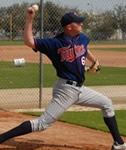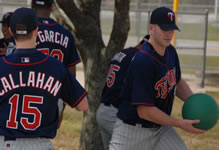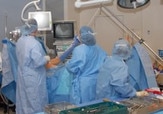|
Successful shoulder surgery begins with the training and experience of your physician. In 1994, Dr. Joyce completed a Fellowship in Shoulders with Dr. James Andrews and Dr. William Clancy at the American Sports Medicine Institute. While some surgeons consider these surgeries "new", Dr. Joyce has been doing arthroscopic stability surgery and rotator cuff repairs for more that 10 years.
Dr. Dukas has also completed a fellowship that incorporated both simple and complex shoulder surgery. He has extensive training in both the latest minimally invasive arthroscopic, but also open shoulder surgery. Sometimes a shoulder injury is too substantial to be handled through arthroscopic means and requires the skill of a specialist. Dr. Dukas is extensively trained in the latest pioneering techniques. Dr. Dukas performs complex procedures such as latarjet, fracture surgery, reverse and anatomic shoulder arthroplasty as well as the less common such as trapezius and latissimus tendon transfers when indicated. Arthroscopy has revolutionized the surgeons ability to help patients with a multitude of shoulder problems. With a joint as complex as the shoulder there are many things that can go wrong. The patient may experience pain, stiffness, weakness or instability; each can have many explanations. When the only treatment available was an open surgical procedure, the surgeon took his best guess and operated on that single problem. When he was right, things went well, but when he was wrong there was little inter-operative recourse. When Dr. Joyce sees a patient with shoulder problems a detailed history will offer the first clue to treatment. He can then learn more about what could be wrong by evaluating the anatomy using digital x-rays or possibly an MRI. He prefers to order each study as it should be customized to specific patient needs. Knowing the anatomy is rarely enough when it comes to an injured shoulder, it is critical to understand the physiology (function). To evaluate the function of the shoulder Dr. Joyce will often have the patient complete a course of very specific physical therapy. If physical therapy fails to alleviate the patient’s symptom, valuable information will have been gained that will aid further treatment. |
If you would like to make an appointment for shoulder evaluation please follow the link above
|
If surgery becomes necessary, several things happen in the operating room. Once under anesthesia, the shoulder can be fully examined without causing the patient discomfort and pain. Then, with the arthroscopy inserted though a small ¼ inch puncture incision the entire shoulder joint can be visualized. Combining this intra-operative information with the patient’s history, MRI, X-Rays, and response to physical therapy each patient’s problems can be fully understood and the final arthroscopic surgical treatment completed.
Shoulder Arthroscopy

Arthroscopic shoulder surgery can treat a broad array of different shoulder problems. Some problems are the result of specific shoulder injuries, while other conditions arise either spontaneously or through overuse.
Surgery is an outpatient procedure that requires a general anesthesia. Most patients will also receive a nerve block by the Anesthesiologist. The nerve block takes about 15 minutes and entails the injection of a long acting local medicine similar to novocaine. With this in place your shoulder and arm will be numb and therefore require less general anesthesia allowing you to wake up from your surgery pain free. The block will last from several hours to overnight.
Arthroscopic shoulder surgery is performed through 2-4 small (less than ¼ inch) puncture incisions used to insert the camera and surgical instruments. At the time of surgery damaged tissue is either removed or repaired. Every patient’s procedure is unique to their specific problem, or combination of problems. You will go home with a padded sling and begin physical therapy within a couple days of surgery.
Surgery is an outpatient procedure that requires a general anesthesia. Most patients will also receive a nerve block by the Anesthesiologist. The nerve block takes about 15 minutes and entails the injection of a long acting local medicine similar to novocaine. With this in place your shoulder and arm will be numb and therefore require less general anesthesia allowing you to wake up from your surgery pain free. The block will last from several hours to overnight.
Arthroscopic shoulder surgery is performed through 2-4 small (less than ¼ inch) puncture incisions used to insert the camera and surgical instruments. At the time of surgery damaged tissue is either removed or repaired. Every patient’s procedure is unique to their specific problem, or combination of problems. You will go home with a padded sling and begin physical therapy within a couple days of surgery.
Arthroscopic Shoulder Rotator Cuff Repair

Arthroscopic repair of a torn rotator cuff has been a revolutionary advancement for many patients. This is a technically demanding procedure best performed by surgeons with fellowship training and much experience. Dr. Dukas and Dr. Joyce are highly skilled in arthroscopic rotator cuff repairs.
The advantage of arthroscopic repair is the ability to treat associated damage, better visualize the full extent of the tear, and to complete the repair in a more anatomical fashion. The surgeon does not cut through the muscle layers overlying the shoulder as with an open procedure, allowing for decreased post operative pain and an easier recovery for the patient. Recovery still requires time for the repaired tendon to fully heal, just as it would if the procedure was done as a traditional open operation.
We classify all rotator cuff repairs by the size of the tear and then customize the post-operative rehabilitation to one of 5 different protocols. Our providers have developed a comprehensive set of protocols that will be tailored for your injury and recovery.
The advantage of arthroscopic repair is the ability to treat associated damage, better visualize the full extent of the tear, and to complete the repair in a more anatomical fashion. The surgeon does not cut through the muscle layers overlying the shoulder as with an open procedure, allowing for decreased post operative pain and an easier recovery for the patient. Recovery still requires time for the repaired tendon to fully heal, just as it would if the procedure was done as a traditional open operation.
We classify all rotator cuff repairs by the size of the tear and then customize the post-operative rehabilitation to one of 5 different protocols. Our providers have developed a comprehensive set of protocols that will be tailored for your injury and recovery.
Shoulder Impingement Syndrome & Arthroscopic Subacromial Decompression
Impingement syndrome is one of the most common shoulder problems. Symptoms arise spontaneously or, often times, it is associated with an overuse condition. Most patients can recover without surgery; physical therapy and home exercises can restore normal shoulder functions, which usually lead to a resolution of symptoms. While some physicians will recommend a cortisone injection, both Dr. Dukas and Dr. Joyce rarely will use this treatment option.
For the patients that do not recover with physical therapy, a Shoulder Arthroscopic Subacromial Decompression may be recommended. This operation involves the arthroscopic removal of the bone spur rubbing on the rotator cuff. Surgery takes about 30 minutes and the patient will recover within several weeks with physical therapy. Patients are allowed to perform daily activities within days of their surgery.
For the patients that do not recover with physical therapy, a Shoulder Arthroscopic Subacromial Decompression may be recommended. This operation involves the arthroscopic removal of the bone spur rubbing on the rotator cuff. Surgery takes about 30 minutes and the patient will recover within several weeks with physical therapy. Patients are allowed to perform daily activities within days of their surgery.
Shoulder Instability, Labral Repairs and Shoulder Dislocations

For many patients with shoulder stability problems satisfactory resolution of symptoms can be achieved with physical therapy and changes in activities. For some patients this treatment is inadequate and they continue to have recurrent episodes of shoulder dislocation, partial dislocation, or simply the sensation of apprehension within the shoulder. In this case arthroscopic shoulder labral repair and stabilization surgery can lead to a resolution of symptoms and permit the patient to return to activities and sports participation.
Advances in technology now allow this operation to be completed entirely arthroscopically through small puncture incisions. With less invasive surgery post-operative physical therapy can begin sooner and with less pain. It still takes several months for the repair to fully heal, but most patients will begin vigorous overhead use of their shoulder within four months of surgery. For athletes, return to sports is within 4-6 months depending on their specific sport and position. Many elite college and professional athletes have been treated by Dr. Joyce, Dr. Dukas, and Dr. Merrill for shoulder instability allowing them a successful return to their sport.
When it comes to instability and labral injuries, every patient is unique. Each patients MRI and injury history gives excellent clues to their specific problem and treatment plan. Your physician will discuss the benefits and risks of arthroscopic shoulder surgery at your consultation.
Advances in technology now allow this operation to be completed entirely arthroscopically through small puncture incisions. With less invasive surgery post-operative physical therapy can begin sooner and with less pain. It still takes several months for the repair to fully heal, but most patients will begin vigorous overhead use of their shoulder within four months of surgery. For athletes, return to sports is within 4-6 months depending on their specific sport and position. Many elite college and professional athletes have been treated by Dr. Joyce, Dr. Dukas, and Dr. Merrill for shoulder instability allowing them a successful return to their sport.
When it comes to instability and labral injuries, every patient is unique. Each patients MRI and injury history gives excellent clues to their specific problem and treatment plan. Your physician will discuss the benefits and risks of arthroscopic shoulder surgery at your consultation.
Pectoralis Muscle Injury
The pectoralis muscle is a large muscle that is located in front of your chest and helps to move your shoulder forwards and across your chest. The pectoralis muscle is divided into the pectoralis major and the pectoralis minor. The pectoralis major muscle is the larger muscle and helps to push the arms in front of the body. Both Dr Dukas and Dr. Joyce specializes in injury to the pec major.
The pectoralis major muscle or its tendon that gets attached to the arm bone (the humerus) can rupture or tear completely. It is quite rare and occurs only in men between the age of 20 and 50 years. Pectoralis muscle rupture may lead to partial or complete tear of the muscle. Partial ruptures are less common and complete rupture occurs when the tendinous attachment of the muscle to the bone tears.
Torn pectoral muscles are most often caused by forceful activities such as weightlifting, especially during a bench press exercise. The condition might also result from sports such as football, wrestling, rugby, and other traumatic accidents or injuries. These injuries are more likely to occur in patients who use steroid medication.
When the pectoralis muscle ruptures, you will have sudden severe pain and a tearing sensation in the chest. You may also have pain in the upper arm, weakness, bruising, and a dimpling, or pocket formation above the arm pit.
Initial treatment includes application of ice and immobilization of the shoulder, arm and chest. Surgery is often required for complete tears of the pectoralis muscle tendon, while partial tears can be managed without surgery. Your physician will counsel you on your specific risks and benefits as well as treatment options. If surgery is needed, they will work with you to customize your rehab afterwards with your specific goals in mind. If surgery is not needed they will educate you on prevention. Pectoralis muscle rupture can be prevented by following certain instructions on proper bench press technique. For proper bench press technique, it is important to limit the distance to which the bar is lowered, and also narrowing the grip of the hands to the bar.
The pectoralis major muscle or its tendon that gets attached to the arm bone (the humerus) can rupture or tear completely. It is quite rare and occurs only in men between the age of 20 and 50 years. Pectoralis muscle rupture may lead to partial or complete tear of the muscle. Partial ruptures are less common and complete rupture occurs when the tendinous attachment of the muscle to the bone tears.
Torn pectoral muscles are most often caused by forceful activities such as weightlifting, especially during a bench press exercise. The condition might also result from sports such as football, wrestling, rugby, and other traumatic accidents or injuries. These injuries are more likely to occur in patients who use steroid medication.
When the pectoralis muscle ruptures, you will have sudden severe pain and a tearing sensation in the chest. You may also have pain in the upper arm, weakness, bruising, and a dimpling, or pocket formation above the arm pit.
Initial treatment includes application of ice and immobilization of the shoulder, arm and chest. Surgery is often required for complete tears of the pectoralis muscle tendon, while partial tears can be managed without surgery. Your physician will counsel you on your specific risks and benefits as well as treatment options. If surgery is needed, they will work with you to customize your rehab afterwards with your specific goals in mind. If surgery is not needed they will educate you on prevention. Pectoralis muscle rupture can be prevented by following certain instructions on proper bench press technique. For proper bench press technique, it is important to limit the distance to which the bar is lowered, and also narrowing the grip of the hands to the bar.

